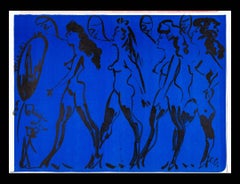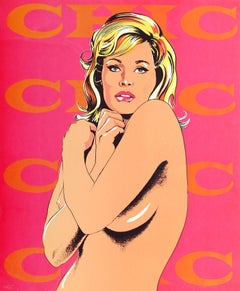Mid-20th Century Nude Prints
to
97
351
136
79
15
5
Overall Width
to
Overall Height
to
276
118
18
14
12
9
9
3
2
65
31
27
24
19
22
55
1,821
658
28
81
132
113
54
134
227
426
228
104
15
449
132
2
456
286
263
193
110
110
102
90
71
13
13
12
12
11
10
10
9
8
7
7
276
201
62
33
27
72
146
292
260
Period: Mid-20th Century
Courtisane au lit avec un visiteur (Bloch 1553), Modern Etching by Pablo Picasso
Located in Long Island City, NY
This captivating portrait by Pablo Picasso features an artist in the foreground rendered in profile while a nude model reclines against a bed with her leg crossed over her knee and h...
Category
Modern Mid-20th Century Nude Prints
Materials
Etching
Modele et Grande Sculpture de Dos (Bloch 186), Modern Etching by Pablo Picasso
Located in Long Island City, NY
Standing before the large nude sculpture, the model admires the statue before her in this work by Pablo Picasso. Nude like herself, the model's presence in the studio creates a balan...
Category
Modern Mid-20th Century Nude Prints
Materials
Etching
Claes Oldenburg Parade of Women lithograph (1 cent life)
Located in NEW YORK, NY
Claes Oldenburg Parade of Women (from One Cent Life), 1964:
Lithograph printed in colors.
16.25 x 22.75 in (41.28 x 57.79 cm).
Minor signs of handling; otherwise excellent overall v...
Category
Pop Art Mid-20th Century Nude Prints
Materials
Lithograph
Chic, from 11 Pop Artists Vol. I
By Mel Ramos
Located in Miami, FL
Mel Ramos
Chic, from 11 Pop Artists Vol. I
1965
Screenprint
24 x 20 in.
11/200
Pencil signed and numbered
This print is included in the Smithsonian American Art Museum collection.
...
Category
Pop Art Mid-20th Century Nude Prints
Materials
Screen
Venus Noir
Located in San Francisco, CA
This artwork titled "venus Noir" from the suite "The Mujeres File" 1969 is an original colors lithograph on BFK Rives paper by renown Mexican artist Rufino Tamayo, 1899-1991. It is h...
Category
Modern Mid-20th Century Nude Prints
Materials
Lithograph
Carnavalesque
Located in San Francisco, CA
This artwork titled "Carnavalesque" from the suite "The Mujeres File" 1969 is an original colors lithograph on BFK Rives paper by renown Mexican artist Rufino Tamayo, 1899-1991. It i...
Category
Modern Mid-20th Century Nude Prints
Materials
Lithograph
Personnages et Nu (Characters and Nude)
Located in Laguna Beach, CA
Discover the artistic brilliance of Pablo Picasso through his iconic artwork, Personnages et Nu (Characters and Nude), created in 1960. This captivating piece centers around a female...
Category
Modern Mid-20th Century Nude Prints
Materials
Etching
La Negra (The Black Woman)
Located in San Francisco, CA
This artwork titled "La Negra (The Black Woman)" from the suite "The Mujeres File" 1969 is an original colors lithograph on B.F.K. Rives paper by renown Mexican artist Rufino Tamayo, 1899-1991. It is hand signed and numbered 150/150 in pencil by the artist. The image size is 26.85 x 21.25 inches, sheet size is 29.5 x 22.15 inches, framed size is 42 x 35 inches. Published by Touchtone Publisher, New York, printed by Ateliers Desjobert, Paris. Referenced and pictured in the artist's catalogue raisonne by Pereda, plate #109 page 107. Custom framed in a wooden silver frame, with silver spacer and fabric matting. It is in excellent condition.
About the artist:
A native of Oaxaca in Southern Mexico, Rufino Tamayo's father was a shoemaker, and his mother a seamstress. Some accounts state that he was descended from Zapotec Indians, but he was actually 'mestizo' - of mixed indigenous/European ancestry. (Santa Barbara Museum of Art). He began painting at age 11. Orphaned at the age of 12, Tamayo moved to Mexico City, where he was raised by his maternal aunt who owned a wholesale fruit business.
In 1917, he entered the San Carlos Academy of Fine Arts, but left soon after to pursue independent study. Four years later, Tamayo was appointed the head designer of the department of ethnographic drawings at the National Museum of Archaeology in Mexico City. There he was surrounded by pre-Colombian objects, an aesthetic inspiration that would play a pivotal role in his life. In his own work, Tamayo integrated the forms and tones of pre-Columbian ceramics into his early still lives and portraits of Mexican men and women.
In the early 1920s he also taught art classes in Mexico City's public schools. Despite his involvement in Mexican history, he did not subscribe to the idea of art as nationalistic propaganda. Modern Mexican art at that time was dominated by 'The Three Great Ones' : Diego Rivera, Jose Clemente Orozco, and David Alfaro Siqueros, but Tamayo began to be noted as someone 'new' and different' for his blending of the aesthetics of post Revolutionary Mexico with the vanguard artists of Europe and the United States.
After the Mexican Revolution, he focused on creating his own identity in his work, expressing what he thought was the traditional Mexico, and refusing to follow the political trends of his contemporary artists. This caused some to see him as a 'traitor' to the political cause, and he felt it difficult to freely express himself in his art. As a result, he decided to leave Mexico in 1926 and move to New York, along with his friend, the composer Carlos Chavez. The first exhibition of Tamayo's work in the United States was held at the Weyhe Gallery, New York, in that same year. The show was successful, and Tamayo was praised for his 'authentic' status as a Mexican of 'indigenous heritage', and for his internationally appealing Modernist aesthetic. (Santa Barbara Museum of Art).
Throughout the late thirties and early forties New York's Valentine Gallery gave him shows. For nine years, beginning in 1938, he taught at the Dalton School in New York.
In 1929, some health problems led him to return to Mexico for treatment. While there he took a series of teaching jobs. During this period he became romantically involved with the artist Maria Izquierdo...
Category
Modern Mid-20th Century Nude Prints
Materials
Lithograph
Reflexion du Peintre sur la Vie (Reflection of the Painter on Life)
Located in Laguna Beach, CA
Drypoint, 1967. 350x300 mm; 13 5/8x11 5/8 inches, full margins. With the artist's ink stamp signature, lower right, and numbered 38/50 in pencil, lower left. A very good impression. ...
Category
Cubist Mid-20th Century Nude Prints
Materials
Drypoint

